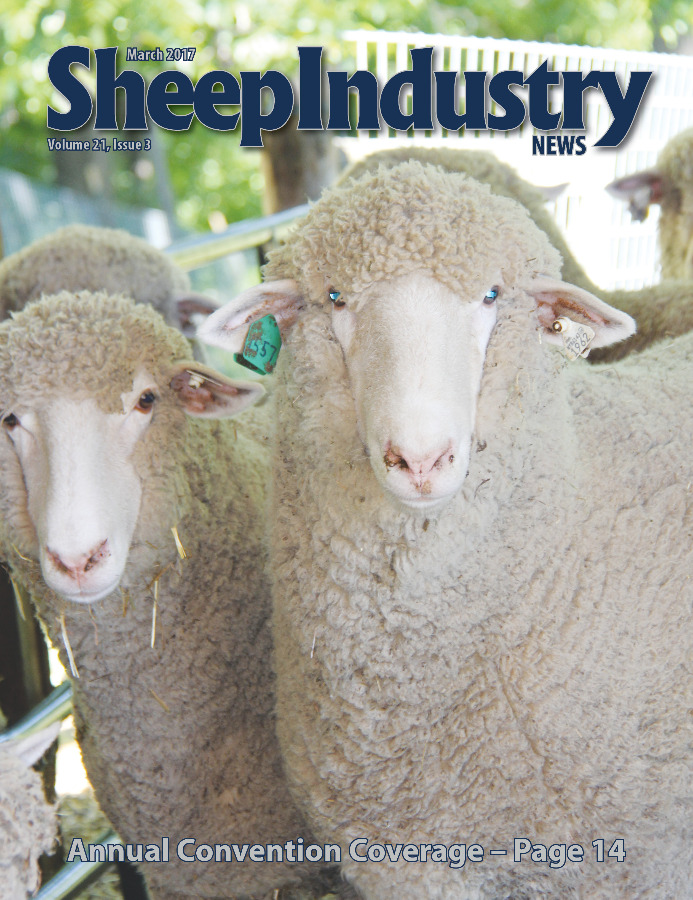
- March 2017
- President’s Notes
- Montana Sheep Conflicts Examined
- ASI Headed to Washington this Month
- Hahn Tops Shearing Field
- Convention: American Wool…Branded for the Future
- Convention: Branding American Wool
- Convention: Officers, Executive Board Elected
- Convention: Industry Veterans Honored
- Convention: Abiding by VFD Regulations
- Convention: States Share Highlights, Challenges
- Convention: Social Media Takes Center Stage
- Convention: FMD Focus of Animal Health
- Convention: WS Aerial Program a Priority
- Convention: Preparing for the New Farm Bill
- Convention: PERC Hears from Researchers
- Convention: EBVs Pay Off for Producers
- Convention: Lamb News is Encouraging
- Convention: The Fleece Awakens at MIWW
- Webinars Prove Informative
- Round 5 of Let’s Grow Grants Open
- Market Report
- The Last Word
States Share Highlights, Challenges
KYLE PARTAIN
Sheep Industry News Editor
A federation of 45 state sheep associations, one of ASI’s top priorities is to assist those associations in growing the American sheep industry at the grass roots level.
One way to spur such growth is to gather leaders from the state associations each year during the ASI Annual Convention in a support group-style setting that facilitates the sharing of ideas and strategies, as well as problems and difficulties. Representatives from about half of the state associations were on hand in Denver in late January to take advantage of the annual gathering.
A roll call discussion included the opportunity to share successes, failures and frustrations among executive directors and state presidents. In addition, the state representatives heard presentations from the Let’s Grow Committee, the ASI office staff and the American Lamb Board. The session closed with a panel discussion moderated by Tonia Fuller of the Utah Wool Growers Association. The panel members were Bonnie Brown of Colorado, Amy Hendrickson of Wyoming, Roger High of Ohio and Erica Sanko of California.
State reports included the following:
• After originally deciding to cancel the 2017 Iowa Sheep and Wool Festival, the event is back on and moving to a new venue this summer.
• Despite dealing with the worst in-state economy in recent memory – thanks to the energy bust – Wyoming is hiring a sheep extension specialist for the first time in approximately 20 years. Membership within the state association also continues to grow.
• California has adopted a new strategic plan, revamped its board of directors and is using its online presence to sell animal health products. The win-win situation for the state association and producers has been well received.
• Minnesota hired a new sheep specialist – shared with North Dakota – in 2016.
• While targeting young producers, Texas is seeing tremendous growth among producers between the ages of 40 to 60 – many of whom are newcomers to the livestock industry.
• Public land issues continue to be the top priority in Idaho, as more than half the state is controlled by the federal government.
• North Dakota’s starter flock program is approaching the 1,000-ewe mark, and the state’s two annual ram sales have proven beneficial for both the association and its producers.
• Utah has worked to develop its young producer group, which responds well to social events and networking opportunities.
• Indiana received great local coverage of the state’s Make It With Wool contest in the past year, and would like to plan a short course on sheep basics for new producers.
• South Dakota continues to see interest in lamb while serving samples at a South Dakota State University basketball game each season. The all-volunteer association also wants to do more to get young producers involved.
• Montana hired a new executive secretary in the past year and revamped its website. The association continues to put on a successful ram sale.
• Interest in the Wisconsin Sheep and Wool Festival continues to grow and draw in attendees from all across Wisconsin and neighboring states.
• The Ohio Sheep Improvement Association improved its digital presence with a new website and attention to social media.
“I wish every state could have an executive to handle the day-to-day working of the association, because I know they would all be stronger,” said High. “I know that some states don’t have that option, but there are still ways to build the association and grow the industry. That’s why we’re here today.”

